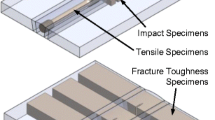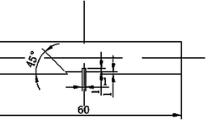Conclusions
-
1.
The pores formed during heating to quenching temperature in a humid atmosphere and in vacuum have different origins-interaction of the metal with water vapor and evaporation of zinc, respectively. The formation of pores sharply increases the susceptibility of the alloy to delayed fracture.
-
2.
It was established that pores form in the surface layer of the samples. Thus, the susceptibility to dolayed fracture can be reduced by removing the surface layer.
Similar content being viewed by others
Literature cited
P. Forsyth and D. Ryder, Metallurgiya,63 (1961).
R. Nicholson and G. Lorimer, Acta Met.,14, No. 8 (1966).
L. L. Kunin, Surface Phenomena in Metals [in Russian], Metallurgizdat, Moscow (1955).
Yu. A. Klyachko, Zh. Prikl. Khim.,22 (1949).
S. Z. Bokshtein, S. T. Kishkin, D. A. Giunashvili, and T. I. Gudkova, Metal, i Term. Obrabotka Metal., No. 8 (1966).
B. A. Kalachev, Hydrogen Embrittlement of Nonferrous Metals [in Russian], Metallurgiya, Moscow (1966).
Additional information
Translated from Metallovedenie i Termicheskaya Obrabotka Metallov, No. 7, pp. 72–74, July, 1968.
Rights and permissions
About this article
Cite this article
Zenkova, É.K., Podgorskii, B.N. Effect of furnace atmosphere on susceptibility to delayed fracture of alloy ATsM. Met Sci Heat Treat 10, 567–569 (1968). https://doi.org/10.1007/BF00654373
Issue Date:
DOI: https://doi.org/10.1007/BF00654373




